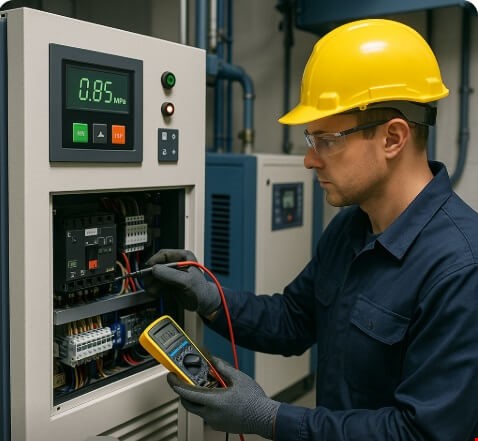Cyclone water separators fundamentally differ from other separation technologies by harnessing centrifugal forces to quickly and efficiently remove large droplets from compressed air. Let’s dive deeper into how they compare with other methods.
How Air Compressor Cyclone Water Separators Work?
Cyclone water separators operate by introducing the compressed air into a cylindrical or conical chamber where the airflow is forced into a vortex. This spinning motion generates centrifugal forces that push heavier water droplets toward the outer wall. The droplets then coalesce or fall into a collection area, while the drier air exits from the top or center of the separator, typically with minimal pressure drop.
Here’s a simple flow diagram:
Compressed Air Inlet
│
▼
[ Cyclone Chamber ]
│ ← Vortex generated here
▼
Heavy Liquid Droplets → Settle/Drain
│
▼
Drier Compressed Air Outlet
Advantages of Cyclone Water Separators
1. Low Pressure Drop: Their design allows for separation with minimal resistance, ensuring that the system maintains a high flow rate of air—a crucial factor in many industrial processes.
2. Robust and Durable: With a simple, no-moving-parts construction, these separators are resistant to wear and require less frequent maintenance compared to more complex systems.
3.Cost-Effective Pre-Treatment: They often serve as the first stage in a multi-step air treatment system, effectively removing large moisture particles before the air reaches more sensitive components like filters and dryers. This can reduce overall operating costs and extend the life of subsequent equipment.
4. High Throughput Capability: Because they quickly remove significant moisture, they’re well-suited to systems with large volumes of compressed air.
Comparison with Other Technologies
Below is a breakdown of various compressed air separation technologies:
| Technology |
Operating Principle |
Advantages |
Disadvantages |
| Cyclone Water Separators |
Centrifugal force creates a vortex that removes larger water droplets |
Low pressure drop, robust, simple design |
Less effective for very fine droplets; may require additional filtration for ultra-dry air needs |
| Coalescing Filters |
Fine filter media captures and coalesces small water droplets into larger ones |
Effective removal of fine and ultrafine droplets, improves air purity |
Higher pressure drop, more frequent maintenance, and replacement of filter elements |
| Refrigerant/Desiccant Dryers |
Cooling the air to condense moisture (refrigerant) or adsorbing water (desiccants) |
Achieves extremely low dew points, ideal for sensitive applications |
More complex installation, higher costs, and increased operational expenses |
- Cyclone vs. Coalescing Filters: Cyclone separators are excellent as a first stage to remove the bulk of the moisture with minimal cost and complexity, whereas coalescing filters target finer particulates and droplets but introduce more resistance in the airflow and need regular maintenance.
- Cyclone vs. Dryers: Refrigerant and desiccant dryers are specialized for reaching very low moisture content levels necessary for certain industrial processes where even a small amount of water can be detrimental. In contrast, cyclone separators handle larger droplets efficiently but might be used in tandem with dryers for comprehensive moisture control. In contrast, cyclone separators handle larger droplets efficiently but might be used in tandem with dryers for comprehensive moisture control.
Choosing the Right Separation System
The decision to use a cyclone water separator, either alone or in combination with other technologies, depends on factors such as:
- The level of moisture removal required: For many applications, removing larger droplets to improve the efficiency of subsequent filters or dryers is sufficient.
- System design and energy efficiency needs: If maintaining a low pressure drop is critical, cyclone separators offer an advantage.
- Maintenance considerations and cost efficiency: The robust and simple design minimizes downtime and long-term operational costs.
- Complementary system integration: Often, cyclone water separators are integrated as a pre-treatment step to enhance the performance and longevity of complete compressed air systems.
Further Considerations and Questions
- Optimization: Integrating a cyclone separator ahead of more sensitive moisture control equipment can greatly optimize overall system performance. It’s worth exploring case studies where industries improved system reliability and reduced maintenance costs with this staged approach.
- Design Specifics: The geometry and design parameters (such as cone angle, inlet configuration, and drainage setup) of cyclone separators can be tailored to suit specific applications. Understanding these details could lead to custom solutions that further enhance efficiency.
- Environmental Factors: In environments with extremely high humidity or particulate content, you might need to adapt the design or combine it with other technologies to achieve the target air quality.
For Further information about air compressor cyclone water separators and more, feel free to contact us.
This might also interest you:

5 Common Industrial Air Compressor Problems & Solutions

Permanent Magnet Motor Compared to Induction Motor